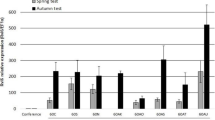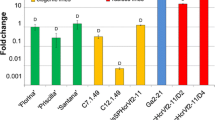Abstract
Cisgenic apple plants of two different cultivars were developed by transferring the Rvi6 scab resistance gene of Malus floribunda 821, using a new transformation vector based on the Flp/FRT recombinase system. Transformation experiments on seven different cultivars resulted in 22 transgenic lines for the cultivars ‘Brookfield Baigent’, ‘Mitchgla’, ‘Novajo’, and ‘Pinova’, whereby 16 lines thereof were resistant to Venturia inaequalis strain 104 (race 1). Analysis of the transgenic lines revealed Rvi6 mRNA expression levels comparable to several traditional bred Rvi6 containing cultivars and identified four transgenic lines, harboring a single T-DNA insertion, as suitable for the production of cisgenic lines. The T-DNA insertion site of these lines was determined, and lines were subject to induction of the recombinase system. Two cisgenic lines originating from the cultivars ‘Brookfield Baigent’ and ‘Pinova’ were obtained for which the exact excision of the recombinase cassette was confirmed by sequencing the previously determined T-DNA integration site. Further investigations revealed both cisgenic lines as fully resistant to V. inaequalis race 1. Rvi6 mRNA expression of the cisgenic lines and traditionally bred Rvi6 harboring cultivars was still comparable. The transformation vector developed is useable for the production of cisgenic apple plants to a certain extent.



Similar content being viewed by others
References
Barbieri M et al (2003) Progress of map-based cloning of the Vf-resistance gene and functional verification: preliminary results from expression studies in transformed apple. HortScience 38:329–331
Belfanti E et al (2004) The HcrVf2 gene from a wild apple confers scab resistance to a transgenic cultivated variety. Proc Natl Acad Sci USA 101:886–890. doi:10.1073/pnas.0304808101
Bonny S (2003) Why are most Europeans opposed to GMOs? Factors explaining rejection in France and Europe. Electr J Biotechnol 6:50–71
Boone DM (1971) Genetics of Venturia inaequalis. Annu Rev Phytopathol 9:297–318. doi:10.1146/annurev.py.09.090171.001501
Borejsza-Wysocka E, Norelli J, Aldwinckle H, Malnoy M (2010) Stable expression and phenotypic impact of attacin E transgene in orchard grown apple trees over a 12 year period. BMC Biotechnol 10:1–9. doi:10.1186/1472-6750-10-41
Brown S (2012) Apple. In: Badenes ML, Byrne DH (eds) Fruit breeding. Handbook of plant breeding, vol 8. Springer, USA, pp 329–367. doi:10.1007/978-1-4419-0763-9_10
Bus VGM, Rikkerink EHA, Caffier V, Durel CE, Plummers KM (2011) Revision of nomenclature of the differential host-pathogen interactions of Venturia inaequalis and Malus. Annu Rev Phytopathol 49:391–413. doi:10.1146/annurev-phyto-072910-095339
BVL (2012) Position statement of the ZKBS on new plant breeding techniques http://www.bvl.bund.de/SharedDocs/Downloads/06_Gentechnik/ZKBS/02_Allgemeine_Stellungnahmen_englisch/05_plants/zkbs_plants_new_plant_breeding_techniques.pdf?__blob=publicationFile&v=2. Accessed 18 June 2014
Chevalier M, Lespinasse Y, Renaudin S (1991) A microscopic study of the different classes of symptoms coded by the Vf gene in apple for resistance to scab (Venturia inaequalis). Plant Pathol 40:249–256. doi:10.1111/j.1365-3059.1991.tb02374.x
Crandall CS (1926) Apple breeding at the University of Illinois, III. Agric Exp Stn Bull 275:341–600
Dangl JL, Jones JDG (2001) Plant pathogens and integrated defence responses to infection. Nature 411:826–833
De Bondt A, Eggermont K, Penninckx I, Goderis I, Broekaert WF (1996) Agrobacterium-mediated transformation of apple (Malus× domestica Borkh.): an assessment of factors affecting regeneration of transgenic plants. Plant Cell Rep 15:549–554. doi:10.1007/bf00232992
de Vetten N et al (2003) A transformation method for obtaining marker-free plants of a cross-pollinating and vegetatively propagated crop. Nat Biotechnol 21:439–442. doi:10.1038/nbt801
Durel CE et al (2004) An overview of the position and robustness of scab resistance QTLs and major genes by aligning of genetic maps in five apple progenies. Acta Hortic 663:135–140
EFSA Panel on Genetically Modified Organisms (GMO) (2010) Guidance on the environmental risk assessment of genetically modified plants. EFSA J 8:1–111. doi:10.2903/j.efsa.2010.1879
EFSA Panel on Genetically Modified Organisms (GMO) (2011) Guidance for risk assessment of food and feed from genetically modified plants. EFSA J 9:1–37. doi:10.2903/j.efsa.2011.2150
EFSA Panel on Genetically Modified Organisms (GMO) (2012) Scientific opinion addressing the safety assessment of plants developed through cisgenesis and intragenesis. EFSA J 10:1–33. doi:10.2903/j.efsa.2012.2561
Fischer M (2004) Die Zukunft: krankheitsresistente Apfelsorten. Erwerbs-Obstbau 46:1–6. doi:10.1007/s10341-004-0017-2
Fischer M, Fischer C (2008) The pillnitz re-series of apple cultivars—Do they hold promise? 80 years of professional german fruit breeding. Erwerbs-Obstbau 50:63–67. doi:10.1007/s10341-008-0061-4
Flachowsky H, Peil A, Sopanen T, Elo A, Hanke V (2007) Overexpression of BpMADS4 from silver birch (Betula pendula Roth.) induces early-flowering in apple (Malus× domestica Borkh.). Plant Breed 126:137–145. doi:10.1111/j.1439-0523.2007.01344.x
Flachowsky H et al (2010) Transgenic apple plants overexpressing the Lc gene of maize show an altered growth habit and increased resistance to apple scab and fire blight. Planta 231:623–635. doi:10.1007/s00425-009-1074-4
Flor HH (1971) Current status of the gene-for-gene concept. Annu Rev Phytopathol 9:275–296. doi:10.1146/annurev.py.09.090171.001423
Fulton TM, Chunwongse J, Tanksley SD (1995) Microprep protocol for extraction of DNA from tomato and other herbaceous plants. Plant Mol Biol Rep 13:207–209. doi:10.1007/Bf02670897
Gaskell G et al (2010) Europeans and biotechnology in 2010—Winds of change? Directorate-general for research science in society and food, agriculture, fisheries, and biotechnology. EUR 24537 EN:1-172
Gessler C, Pertot I (2012) Vf scab resistance of Malus. Trees-Struct Funct 26:95–108. doi:10.1007/s00468-011-0618-y
Gessler C, Patocchi A, Sansavini S, Tartarini S, Gianfranceschi L (2006) Venturia inaequalis resistance in apple. Crit Rev Plant Sci 25:473–503. doi:10.1080/07352680601015975
Hättasch C, Flachowsky H, Hanke MV (2009) Evaluation of an alternative d-amino acid/DAAO selection system for transformation in apple (Malus× domestica Borkh.) J Hortic Sci Biotechnol 188–194
Herzog K, Flachowsky H, Deising HB, Hanke MV (2012) Heat-shock-mediated elimination of the nptII marker gene in transgenic apple (Malus× domestica Borkh.). Gene 498:41–49. doi:10.1016/j.gene.2012.01.074
Janick J (2002) History of the PRI apple breeding program. Acta Hortic (ISHS) 595:55–60
Jänsch M et al (2014) A phenotypic, molecular and biochemical characterization of the first cisgenic scab-resistant apple variety ‘Gala’. Plant Mol Biol Rep 32:679–690. doi:10.1007/s11105-013-0682-0
Jha G, Thakur K, Thakur P (2009) The venturia apple pathosystem: pathogenicity mechanisms and plant defense responses. J Biomed Biotechnol 2009:10. doi:10.1155/2009/680160
Joshi SG, Schaart JG, Groenwold R, Jacobsen E, Schouten HJ, Krens FA (2011) Functional analysis and expression profiling of HcrVf1 and HcrVf2 for development of scab resistant cisgenic and intragenic apples. Plant Mol Biol 75:579–591. doi:10.1007/s11103-011-9749-1
Kortstee AJ et al (2011) Anthocyanin production as a potential visual selection marker during plant transformation. Transgenic Res 20:1253–1264. doi:10.1007/s11248-011-9490-1
Liebhard R, Koller B, Gianfranceschi L, Gessler C (2003) Creating a saturated reference map for the apple (Malus× domestica Borkh.) genome. Theor Appl Genet 106:1497–1508. doi:10.1007/s00122-003-1209-0
Lusser M, Parisi C, Plan D, Rodríguez-Cerezo E (2011a) New plant breeding techniques State of-the-art and prospects for commercial development. JRC Ref Rep. doi:10.2791/60346
Lusser M, Parisi C, Plan D, Rodríguez-Cerezo E (2011b) New plant breeding techniques State of-the-art and prospects for commercial development. JRC Sci Tech Rep. doi:10.2791/54761
Malnoy M, Boresjza-Wysocka E, Norelli J, Flaishman M, Gidoni D, Aldwinckle H (2010) Genetic transformation of apple (Malus× domestica) without use of a selectable marker gene. Tree Genet Genomes 6:423–433. doi:10.1007/s11295-009-0260-7
Maximova S, Dandekar A, Guiltinan M (1998) Investigation of Agrobacterium-mediated transformation of apple using green fluorescent protein: high transient expression and low stable transformation suggest that factors other than T-DNA transfer are rate-limiting. Plant Mol Biol 37:549–559. doi:10.1023/A:1006041313209
Parisi L, Lespinasse Y, Guillaumes J, Kruger J (1993) A new race of venturia-inaequalis virulent to apples with resistance due to the Vf. Gene Phytopathol 83:533–537. doi:10.1094/Phyto-83-533
Puite KJ, Schaart JG (1996) Genetic modification of the commercial apple cultivars Gala, Golden Delicious and Elstar via an Agrobacterium tumefaciens-mediated transformation method. Plant Sci 119:125–133. doi:10.1016/0168-9452(96)04448-2
Roßberg D (2009) NEPTUN 2007—Obstbau. Berichte JKI 147:1–71
Roßberg D (2013) Erhebungen zur Anwendung von Pflanzenschutzmitteln in der Praxis im Jahr 2011. J Kultur 65:141–151
Saghai-Maroof MA, Soliman KM, Jorgensen RA, Allard RW (1984) Ribosomal DNA spacer-length polymorphisms in barley: mendelian inheritance, chromosomal location, and population dynamics. Proc Natl Acad Sci 81:8014–8018
Sansavini S, Donati F, Costa F, Tartarini S (2004) Advances in apple breeding for enhanced fruit quality and resistance to biotic stresses: new varieties for the European market. J Fruit Ornam Plant Res 12:13–52
Schaart JG, Krens FA, Pelgrom KTB, Mendes O, Rouwendal GJA (2004) Effective production of marker-free transgenic strawberry plants using inducible site-specific recombination and a bifunctional selectable marker gene. Plant Biotechnol J 2:233–240. doi:10.1111/j.1467-7652.2004.00067.x
Schouten HJ, Krens FA, Jacobsen K, Jacobsen E (2006a) Cisgenic plants are similar to traditionally bred plants—international regulations for genetically modified organisms should be altered to exempt cisgenesis. Embo Rep 7:750–753. doi:10.1038/sj.embor.7400769
Schouten HJ, Krens FA, Jacobsen E (2006b) Do cisgenic plants warrant less stringent oversight? Nat Biotechnol 24:753. doi:10.1038/Nbt0706-753
Schouten HJ, Brinkhuis J, van der Burgh A, Schaart JG, Groenwold R, Broggini GAL, Gessler C (2014) Cloning and functional characterization of the Rvi15 (Vr2) gene for apple scab resistance. Tree Genet Genomes 10:251–260. doi:10.1007/s11295-013-0678-9
Stotz HU, Mitrousia GK, de Wit PJGM, Fitt BDL (2014) Effector-triggered defence against apoplastic fungal pathogens. Trends Plant Sci. doi:10.1016/j.tplants.2014.04.009
Szankowski I et al (2009) Highly scab-resistant transgenic apple lines achieved by introgression of HcrVf2 controlled by different native promoter lengths. Tree Genet Genomes 5:349–358. doi:10.1007/s11295-008-0191-8
Vanblaere T, Szankowski I, Schaart J, Schouten H, Flachowsky H, Broggini GAL, Gessler C (2011) The development of a cisgenic apple plant. J Biotechnol 154:304–311. doi:10.1016/j.jbiotec.2011.05.013
Vanblaere T, Flachowsky H, Gessler C, Broggini GAL (2014) Molecular characterization of cisgenic lines of apple ‘Gala’ carrying the Rvi6 scab resistance gene. Plant Biotechnol J 12:2–9. doi:10.1111/Pbi.12110
Velasco R et al (2010) The genome of the domesticated apple (Malus× domestica Borkh.). Nat Genet 42:833–841. doi:10.1038/Ng.654
Vinatzer BA, Patocchi A, Gianfranceschi L, Tartarini S, Zhang HB, Gessler C, Sansavini S (2001) Apple contains receptor-like genes homologous to the Cladosporium fulvum resistance gene family of tomato with a cluster of genes cosegregating with Vf apple scab resistance. Mol Plant Microbe In 14:508–515. doi:10.1094/Mpmi.2001.14.4.508
Wenzel S, Flachowsky H, Hanke M-V (2013) The Fast-track breeding approach can be improved by heat-induced expression of the FLOWERING LOCUS T genes from poplar (Populus trichocarpa) in apple (Malus× domestica Borkh.). Plant Cell Tissue Organ Cult 115:127–137. doi:10.1007/s11240-013-0346-7
Würdig J, Flachowsky H, Hanke MV (2013) Studies on heat shock induction and transgene expression in order to optimize the Flp/FRT recombinase system in apple (Malus× domestica Borkh.). Plant Cell Tissue Org 115:457–467. doi:10.1007/s11240-013-0376-1
Acknowledgments
The project underlying this manuscript has been funded by the Saxon State, State Ministry of Environment and Agriculture, Germany. The authors alone are responsible for the content of this publication. The authors gratefully acknowledge Uta Hille, Arvid Lauber, Teresa Strunz, and Rosi Müller for technical support.
Conflict of interest
The authors declare that they have no conflict of interest.
Author information
Authors and Affiliations
Corresponding author
Electronic supplementary material
Below is the link to the electronic supplementary material.
Rights and permissions
About this article
Cite this article
Würdig, J., Flachowsky, H., Saß, A. et al. Improving resistance of different apple cultivars using the Rvi6 scab resistance gene in a cisgenic approach based on the Flp/FRT recombinase system. Mol Breeding 35, 95 (2015). https://doi.org/10.1007/s11032-015-0291-8
Received:
Accepted:
Published:
DOI: https://doi.org/10.1007/s11032-015-0291-8




